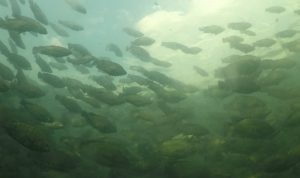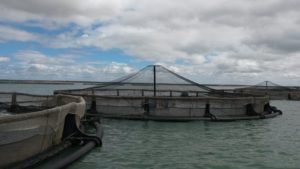São Paulo – Brazil is the fourth-largest producer of tilapia and the country with the highest growth potential in the world. Fish farming has been increasing exponentially for just over a decade, and exports, which began about five years ago, follow the trend, bringing a turning point for the sector.
The segment’s export revenue grew 78% in 2021 compared with 2020, to USD 20.7 million. In volume, growth was 49% over the previous year, with 9,900 tonnes shipped. Frozen fillet sales increased 573% in 2021 year on year. After fresh fillets, it’s the second product with the highest added value in fish farming.

Current leading buyers of tilapia from Brazil are the United States (64%), Colombia (9%), and China (8%). Chile and Canada also buy the fish, mainly in fresh or frozen fillets. “Today, over half of the volume exported goes to the US, but the trend is diversifying destinations,” Manoel Pedroza, a researcher at EMBRAPA Fisheries and Aquaculture, told ANBA. EMBRAPA is the Brazilian Agricultural Research Corporation.
In 2021, production of farmed fish in Brazil reached 841,005 tonnes, 63.5% of which were tilapia, with the rest including species like tambaqui, tambacu, long-whiskered catfish, carp and arapaima (also known as pirarucu), all of which are used for food, said the president of the Brazilian Fish Farming Association (Peixe BR), Francisco Medeiros. This volume represents a 4.7% year-on-year growth. Tilapia production only amounted to 534,005 tonnes, up 9.8% over 2020. Hydroelectric power plant reservoirs have a production capacity of around 3.5 million tonnes a year, which could make Brazil the largest potential producer of tilapia in the world.
“Tilapia and other farmed fish chains are very new in Brazil, about 15 years old, but they are growing a lot and attracting private investment; companies are focused on the foreign market, since the reduction in purchasing power limits the internal expansion, even more in this moment of crisis,” said Pedroza.
Exports last year amounted to almost 10,000 tonnes, 5% of production. The export potential t is very relevant. Since 2019, a federal tax exemption for tilapia has reduced the cost of exports by around 10%. Thus, large animal protein companies, which already export massive volumes of poultry, began investing in fish farms, including cooperatives like Copacol and Paraná’s CVale. Hence, production has been increasing year after year.

“These cooperatives already export a substantial volume of poultry to the Arab countries, but fish is still in a small quantity,” said Pedroza. Fish farming is becoming the export focus for these companies, which already have logistics planning and infrastructure to sell abroad.
Peixe BR, which currently represents 70% of the companies in the sector in the country, has a industry project with the Brazilian Trade and Investment Promotion Agency (Apex-Brasil) to foster participation in shows, B2Bs and industry studies for companies plannning on exporting. Peixe BR president Francisco Medeiros told ANBA that companies such as CVale, JBS and Copacol are already present at most prominent food shows in the world.
“Since they sell poultry, they take tilapia in tow. It’s still a minor presence, but we’re there showing our product,” he said, referring to Gulfood, the most relevant food and beverage trade show in the Middle East and North Africa (MENA), which took place last week in Dubai. Peixe BR has recently joined the Brazilian Association of Animal Protein (ABPA).
According to Medeiros, Arab countries currently buy tilapia from Asian countries and Egypt, as they are closer to each other. He believes Brazilian fish stands out for its quality and safety, in addition to the competitive price. “Brazil has one of the best health control agencies in the world, which guarantees the buyer a top-quality and safe product to eat. Our price and health quality, not only for tilapia but also all other proteins as well, are our main showcase,” he said.
He pointed out that Brazil is already the most crucial poultry supplier to the Arab countries. “Poultry industries such as BR Foods (BRF), Copacol and Seara (JBS) are producing tilapia and will use the same logistics for poultry, following the same sea routes,” he said.

According to the secretary-general of the Arab Brazilian Chamber of Commerce (ABCC), Tamer Mansour, Brazilian poultry are mainly shipped from the Port of Itajaí (in the state of Santa Catarina) and to a lesser extent through the ports of Rio Grande (Rio Grande do Sul), Paranaguá (Paraná) and Santos (São Paulo). The shipments pass through Spain, the Netherlands (Rotterdam) or Germany (Hamburg), then are moved to other ships to continue their journey. The leading Arab ports receiving Brazilian poultry are Jeddah and Dammam (Saudi Arabia), Alexandria (Egypt), and Jebel Ali (United Arab Emirates). “Container movements always take place in Europe. A few ships go straight to Jebel Ali, but it is rare,” Mansour said.
Where they are
The world’s leading tilapia producer is China, followed by the Philippines, Egypt and Brazil. Paraná is currently Brazil’s largest producting state of farmed fish, followed by São Paulo, Bahia, Mato Grosso do Sul, Minas Gerais, and Pernambuco. Over half the exporting companies are concentrated in São Paulo and Paraná.
EMBRAPA Aquaculture was established in Palmas, Tocantins, ten years ago. Pedrosa explained the state is not yet a significant produce, but holds a huge potentialdue to its large soy and maize farms and large volumes of water bodies.
Fresh or frozen
Tilapia production has increased approximately 10% a year, said Peixe BR’s Medeiros. He estimates it will increase between 10% to 12% in 2022 and the next couple of years, due mainly to exports, which he expects to increase by 78% or more this year. He said in January alone, the volume of shipments rose 175% compared to the first month of 2021. Most of this increased volume is going to the same buying countries, but Medeiros hopes to break into new markets with the help of ABPA.

About 50% of what is currently exported is fresh or frozen fillets. “Now, frozen fillet and whole tilapia exports are increasing. Frozen fillet exports stepped up by 650% last year, a figure that’s changing the entire production chain, as frozen fish fillets are an international commodity and a product with higher added value, and Brazil is seizing this opportunity,” said researcher Pedroza. Fresh fillet is transported by plane, while frozen fillet can go by ship, which significantly reduces logistics costs and makes the Brazilian product more competitive overseas.
Tilapia from Brazil goes to supermarkets and restaurants as welll as international production industries. Pedroza said the dollar’s appreciation has brought a higher competitive edge to the exports of Brazilian fishes since the product arrives even cheaper in markets like the US. “On the Arab market, it is certainly good to ship the frozen product. Frozen tilapia could possibly follow on the steps of poultry, a top-rated product in the Arab countries,” he said.
Players such as JBS have recently started producing tilapia, planning to use the Seara brand, initially in the domestic market and later for exports. “We’re experiencing a moment of transformation; tilapia is leaving the domestic chain and starting to become global. Major players are now entering and bringing changes to the sector,” said the researcher.
Halal market
To adapt tilapia production for the Muslim market, it’s necessary to obtain halal certificates to guarantee the quality of the product. According to Dib Tarras, director of the Industrial sector at certifier Fambras Halal, the certification process for fish bred in captivity is based on religious and food safety requirements. “Both production and product processing chains must follow Good Manufacturing Practices (GMP) and implement the HACCP (Hazard Analysis and Critical Control Points) and Halal Assurance System (HAS),” Tarras told ANBA.
The farm-raised fish feed cannot contain animal ingredients, particularly pork, or animals that have not been slaughtered according tothe Sharia law;. This includes by-products such as bone meal, blood, and others. “Fish can only be fed with vegetable or fish-based feed,” emphasized the director.
The slaughter process, or zabiha, does not apply to fish or any other animal without a trachea and jugular vein. Producers just need to follow what the country’s legislation determines. Poisonous or dirt-contaminated fish (najs) are not allowed, and breeding ponds should be away from sewage pits to avoid water contamination.

According to Manoel Pedroza, Brazilian fish feed usually contains grains, such as maize and soy, and a part of animal protein, such as bone and blood meal, which can be beef, poultry or fish, depending on the company. Tarras said the flours with parts of beef or poultry are practically unfeasible due to the complexity of guaranteeing the traceability of these products. He said only one tilapia company in Brazil has the halal certification to date.
Fider Pescados
The business director of Fider Pescados, Juliano Kubitza, told ANBA the company conducts fish farming in nets and processes 800 tonnes of fish per month. Last year, 10,000 tonnes of tilapia were raised, and the director predicts 2022 will reach 15,000 tonnes. Only 10% of production goes to the foreign market. “We started exporting in 2020, and we are optimistic,” said Kubitza.
The United States are the company’s primary international buyer and mainly imports frozen fillets, the company’s highest added value product. Fider uses the whole fish; its trimmings and carcasses go to a factory and are transformed into flour and oil, which are sold to Asia, in addition to the domestic market. They are processed into animal feed, and the collagen from the skin is used in the cosmetics industry. Fider is located in Rifaina, in the countryside of São Paulo, and is part of the MCassab group.
The director said the company is in the process of obtaining halal certification for tilapia. “We have a project to expand exports, and we see the halal market as a potential to explore, even in Brazil. It is a demanding public in terms of quality, and for us, this is interesting,” said Kubitza, emphasizing the quality he seeks in his production.
Mar e Terra
The Unit general manager of Mar e Terra, Gustavo Pchirmer, told ANBA the company already exports tilapia to the US, Canada, and South Africa and is seeking new certificates for other countries.
The company is based in Itaporã, Mato Grosso do Sul, and produced 250 tonnes of live fish a month in 2021. “This year, it will reach an average of 650 tonnes of live fish a month,” Pchirmer said. According to the manager last year, around 250 tonnes were exported in total. “We intend to export around 1,000 tonnes this year,” said Pchirmer.
Mar e Terra belongs to the Pluma group, which also produces poultry under the brand Bello Alimentos. Frozen tilapia uses the exact logistics as poultry protein for exports by ship.
The Peixe BR yearbook was released this Tuesday (22) and is available on the association’s website.
Translated by Elúsio Brasileiro




